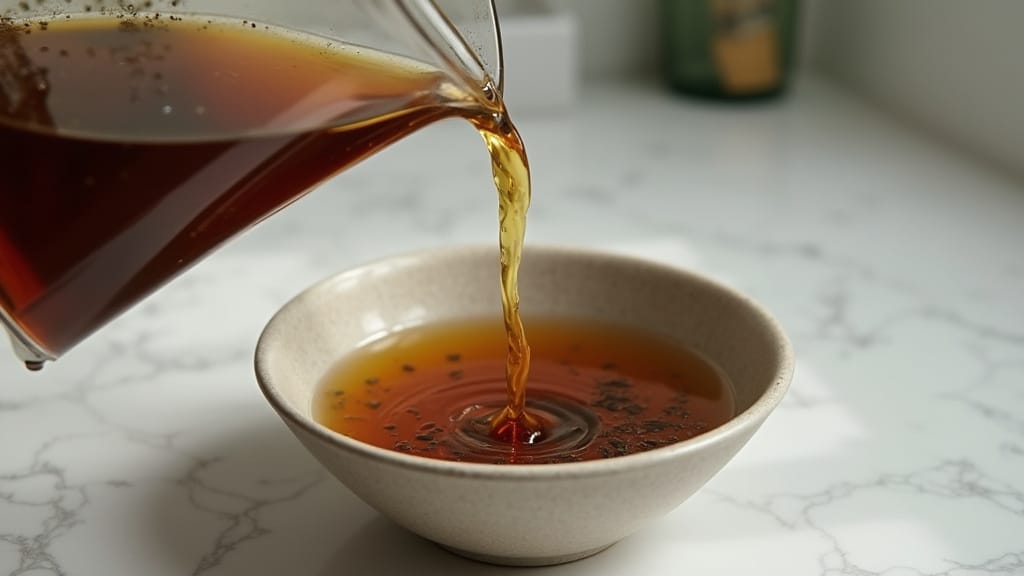How to Make Nettle Hair Rinse
Nettle hair rinse offers a simple, effective way to enhance hair health using a time-tested botanical remedy. This mineral-rich infusion delivers silica, iron, vitamins, and compounds that strengthen hair, soothe the scalp, and add natural shine. Unlike commercial rinses laden with synthetic ingredients, homemade nettle rinse provides pure botanical benefits without harsh chemicals or unnecessary additives.
Traditional herbalists have used nettle (Urtica dioica) rinses for centuries to address common hair concerns: dullness, weak strands, oily scalp, and lackluster growth. The practice persists because it works. Nettle's mineral content fortifies hair structure, its astringent properties balance sebum production, and its anti-inflammatory compounds create an optimal scalp environment for healthy growth.
This guide provides everything needed to create effective nettle hair rinse at home, from sourcing quality nettle to proper preparation techniques, application methods, and storage recommendations. Whether addressing specific hair concerns or simply maintaining healthy hair, nettle rinse offers accessible botanical support.
Why Nettle Works as a Hair Rinse
The Mineral Foundation of Strong Hair
Nettle's effectiveness as a hair rinse stems from its exceptional mineral profile. The plant accumulates silica, iron, calcium, magnesium, potassium, and zinc through its deep taproot system. These minerals don't just sit on the hair surface—they deposit along the hair shaft and absorb into the scalp, providing structural support and nourishment.
Silica deserves particular attention for hair health. This mineral comprises up to 1% of nettle's dry weight, making it one of nature's richest plant sources. Silica strengthens hair's keratin structure, improves elasticity, and reduces breakage. When applied as a rinse, silica compounds create a subtle coating that protects hair while allowing it to remain flexible and natural-looking.
Iron content addresses one of the most common nutritional causes of hair problems. Iron deficiency affects billions worldwide and frequently manifests as dull, weak hair and increased shedding. Nettle rinse delivers topical iron that may help fortify the hair shaft while supporting the scalp tissue that anchors each follicle.
Balancing Scalp Oil Production
Nettle's natural astringent properties help regulate sebum production—the oily substance secreted by scalp glands. Too much sebum creates greasy, limp hair and can contribute to dandruff. Too little leaves hair dry and brittle. Nettle's tannins provide gentle astringency that helps balance oil production without stripping the scalp of necessary moisture.
This balancing act proves valuable for various hair types. Those with oily scalps find that regular nettle rinses extend the time between washes. Those with combination scalps (oily at roots, dry at ends) appreciate how nettle normalizes without exacerbating dryness. Even dry-scalp individuals benefit, as nettle's soothing properties reduce irritation that can trigger reactive oil production.
Anti-Inflammatory and Antimicrobial Benefits
The same compounds that cause nettle's sting when fresh (formic acid, histamine) become anti-inflammatory agents once dried or cooked. These compounds, along with nettle's polyphenols, help calm scalp inflammation that can impair hair health. Chronic scalp inflammation damages follicles, shortens hair growth phase, and contributes to conditions like seborrheic dermatitis.
Nettle also demonstrates antimicrobial activity against common scalp pathogens. While not as potent as dedicated antimicrobial herbs like neem or tea tree, nettle contributes to overall scalp health by helping maintain a balanced microbial environment. This prevents the overgrowth of organisms that cause dandruff, itching, and follicle irritation.
Want deeper understanding of nettle's mechanisms? Read our comprehensive guide on Stinging Nettle for Hair Growth covering DHT-blocking properties, clinical research, and internal use benefits.
How to Make Nettle Hair Rinse: The Basic Recipe

What You'll Need
Essential Ingredients:
- Dried nettle leaves - 1/4 cup (about 0.5 oz)
- Water - 2 cups (16 oz)
Optional Additions:
- Apple cider vinegar - 1-2 tablespoons (enhances shine, helps close cuticles)
- Rosemary - 1 tablespoon dried leaves (adds circulation-boosting properties)
- Peppermint - 1 tablespoon dried leaves (provides cooling sensation, stimulates scalp)
- Lavender essential oil - 3-5 drops (adds calming scent, antimicrobial properties)
Equipment:
- Medium saucepan with lid
- Fine mesh strainer or cheesecloth
- Glass jar or bottle for storage
- Measuring cups and spoons
Basic Nettle Hair Rinse Recipe
This simple formula creates 2 cups of potent nettle rinse—enough for 2-3 applications depending on hair length.
Instructions:
- Measure nettle leaves: Use 1/4 cup dried nettle leaves. If using fresh nettle (which requires gloves for handling), use 1/2 to 3/4 cup as fresh herbs contain more water weight.
- Boil water: Bring 2 cups of water to a full rolling boil in your saucepan. Using filtered or spring water produces the cleanest-tasting rinse, though tap water works fine.
- Add nettle and reduce heat: Once water boils, add the nettle leaves and immediately reduce heat to low simmer. Cover the pot with a lid to prevent volatile compounds from escaping with the steam.
- Simmer for extraction: Maintain a gentle simmer for 20-30 minutes. This extended steeping time ensures maximum mineral extraction. The water will turn dark greenish-brown—this color indicates good extraction.
- Remove from heat and steep: After simmering, turn off heat and let the covered pot sit for an additional 15-20 minutes. This allows the infusion to cool slightly while continuing to extract beneficial compounds.
- Strain thoroughly: Pour the liquid through a fine mesh strainer or cheesecloth into a clean glass jar. Press the nettle leaves gently with a spoon to extract all liquid. Discard the spent leaves (they make excellent compost).
- Add optional ingredients (if using): Once strained and slightly cooled (warm, not hot), add apple cider vinegar or essential oils if desired. Stir well to combine.
- Cool completely: Allow the rinse to reach room temperature before use or storage. Hot rinse can damage hair cuticles and cause scalp discomfort.
Yield: Approximately 1.5-2 cups of finished rinse (some water evaporates during simmering)
Shelf life: 5-7 days refrigerated in sealed glass container
Why Each Step Matters
Extended simmering time (20-30 minutes) breaks down plant cell walls, releasing minerals bound within the leaf structure. Brief steeping extracts surface compounds, but longer extraction captures the full mineral profile that makes nettle rinse effective.
Covering during steeping prevents volatile compounds from escaping with steam. While nettle's benefits come primarily from minerals rather than volatile oils, covering maximizes extraction efficiency and prevents excessive water loss.
Cooling before application protects hair and scalp. Hot water lifts cuticles excessively and can cause scalp sensitivity. Cool or room-temperature rinse closes cuticles smoothly and feels comfortable on skin.
Advanced Nettle Rinse Variations
Nettle-Rosemary Growth-Stimulating Rinse

This combination pairs nettle's minerals with rosemary's circulation-boosting properties for enhanced follicle stimulation.
Ingredients:
- 1/4 cup dried nettle leaves
- 2 tablespoons dried rosemary leaves
- 2 cups water
- 1 tablespoon apple cider vinegar
Follow the basic preparation method, simmering both herbs together. The rosemary adds a pleasant herbal scent while contributing rosmarinic acid and other compounds that improve scalp circulation.
Nettle-Peppermint Cooling Clarifying Rinse
Perfect for oily scalps or hot summer months, this version provides extra clarifying action with a refreshing sensation.
Ingredients:
- 1/4 cup dried nettle leaves
- 2 tablespoons dried peppermint leaves
- 2 cups water
- Optional: 3 drops peppermint essential oil (add after straining)
Peppermint's menthol creates a cooling effect on the scalp while helping dissolve excess oil. This combination works particularly well for those who exercise frequently or have naturally oily hair.
Nettle-Chamomile Soothing Rinse
For sensitive, irritated, or dry scalps, chamomile's anti-inflammatory properties complement nettle's soothing effects.
Ingredients:
- 3 tablespoons dried nettle leaves
- 3 tablespoons dried chamomile flowers
- 2 cups water
This gentler formula suits those whose scalps react to stimulating herbs. Chamomile adds shine while calming any scalp sensitivity.
How to Apply Nettle Hair Rinse
After-Shampoo Application Method
The most common and effective approach uses nettle rinse as the final step after shampooing and conditioning:
- Shampoo and condition normally: Complete your regular washing routine. Rinse conditioner thoroughly with water.
- Apply nettle rinse over sink or tub: Slowly pour the cool or room-temperature rinse over your hair, starting at the crown and working toward ends. Use your free hand to distribute the liquid and ensure it reaches all areas.
- Massage into scalp: Use fingertips to gently massage the rinse into your scalp for 1-2 minutes. This improves absorption and stimulates circulation.
- Squeeze through length: Gently squeeze or run fingers through hair length to distribute rinse from roots to ends.
- Leave in or rinse out: For maximum benefits, don't rinse out—simply squeeze out excess and proceed with styling. For those who prefer, a quick cool water rinse after 2-3 minutes works too, though this reduces mineral deposition.
Pre-Shampoo Deep Treatment

For intensive scalp treatment, apply nettle rinse before shampooing:
- Apply rinse to dry or damp hair, focusing on scalp
- Massage thoroughly for 3-5 minutes
- Cover with shower cap and leave for 20-30 minutes
- Proceed with normal shampooing and conditioning
This method allows longer contact time for deeper mineral penetration and is particularly beneficial for dandruff or scalp conditions.
Leave-In Spray Application
For daily refreshing without full washing:
- Transfer cooled nettle rinse to spray bottle
- Lightly mist onto dry hair, focusing on roots and scalp
- Massage in with fingertips
- Style as usual
This approach works well between wash days to refresh hair, calm scalp itch, or add subtle body and texture.
Frequency Recommendations
Normal to oily hair: Use after every shampoo (2-3 times weekly typically)
Dry or damaged hair: Use 1-2 times weekly to avoid potential drying from tannins
Dandruff or scalp conditions: Use 2-3 times weekly until improvement, then reduce to maintenance level
Color-treated hair: Start with once weekly to ensure no unwanted effects, then increase if desired. Nettle generally doesn't affect color but always test first.
Troubleshooting and Tips for Best Results
Common Questions and Solutions
Q: My hair feels slightly dry after using nettle rinse. What should I do?
A: The tannins in nettle can have a mildly astringent effect. Solutions: (1) Reduce concentration—use 2-3 tablespoons nettle instead of 1/4 cup, (2) Add 1 tablespoon coconut milk to the finished rinse for extra moisture, (3) Follow with a light leave-in conditioner on ends, (4) Reduce frequency to once weekly.
Q: Can I use nettle rinse on color-treated hair?
A: Yes, nettle rinse is generally safe for color-treated hair. The minerals can actually help seal color by smoothing cuticles. However, always patch test first—apply to a small section and wait 24-48 hours to ensure no unwanted color shifts. Nettle doesn't typically alter color, but individual hair chemistry varies.
Q: The rinse has an earthy smell. How can I improve the scent?
A: Nettle's natural aroma is mild but earthy. To enhance: Add 5-10 drops of essential oil after straining (lavender, rosemary, peppermint, or lemon work well). The scent fades quickly as hair dries, leaving no lingering odor.
Q: How long does homemade nettle rinse last?
A: Refrigerated in a sealed glass container, nettle rinse keeps 5-7 days. Signs of spoilage include off smell, cloudiness, or mold. For longer storage, freeze in ice cube trays—thaw one cube per use. Frozen rinse lasts 2-3 months.
Maximizing Effectiveness

Use quality nettle: Bright green, aromatic dried leaves indicate good quality and potency. Brown, dusty nettle has lost effectiveness. Our wildcrafted nettle is harvested at peak potency in spring when mineral content peaks.
Don't skip the massage: Taking 1-2 minutes to massage rinse into the scalp dramatically improves results. Massage stimulates blood flow while helping minerals penetrate.
Be consistent: Like most botanical treatments, nettle rinse works gradually through repeated use. Monthly use shows minimal results. Weekly use over 6-8 weeks demonstrates noticeable improvements in hair strength, shine, and scalp health.
Consider your water: Hard water can interfere with nettle rinse benefits. If you have hard water, adding 1-2 tablespoons apple cider vinegar helps counteract mineral buildup and enhances rinse effectiveness.
Proper Storage and Shelf Life
Refrigeration Storage
For short-term use (5-7 days):
- Store in clean glass jar or bottle with tight-fitting lid
- Keep refrigerated at all times when not in use
- Label with date prepared
- Shake gently before each use (some sediment is normal)
- Discard if any mold, cloudiness, or off smell develops
Freezing for Extended Storage
For longer storage (2-3 months):
- Pour cooled rinse into ice cube trays
- Freeze until solid
- Transfer frozen cubes to labeled freezer bag
- Thaw one cube (approximately 2 tablespoons) per use
- Never refreeze thawed rinse
Freezing preserves the mineral content well, though some volatile compounds may diminish. This method suits those who want nettle rinse available without weekly preparation.
Making Fresh vs. Batch Preparation
Consider your usage pattern when deciding how much to prepare:
Make fresh each week if you:
- Have refrigerator space concerns
- Enjoy the preparation ritual
- Use rinse 2-3 times weekly
- Want maximum potency
Batch prep and freeze if you:
- Want convenience of ready-made rinse
- Use rinse less frequently
- Prefer preparing larger quantities less often
- Have adequate freezer space
Explore more hair care preparations: Learn how to make nettle-infused oil for scalp massage treatments, or discover 8 herbs for comprehensive hair growth support.
Combining Nettle Rinse with Other Hair Care Practices
Complementary Internal Support
Nettle rinse works externally while nettle tea supports hair from within. The combination addresses hair health through multiple pathways: topical mineral delivery plus systemic nutrition, hormone balance, and anti-inflammatory effects.
Consider drinking 1-2 cups of nettle tea daily while using nettle rinse externally 2-3 times weekly. This comprehensive approach often produces better results than external use alone. Our nettle tincture offers a convenient alternative to tea for internal support.
Integrating with Oil Treatments
Nettle rinse and oil treatments serve different purposes and can be used together:
Weekly routine example:
- Sunday evening: Apply nettle-infused oil to scalp, leave overnight
- Monday morning: Shampoo to remove oil, follow with nettle rinse
- Thursday: Regular shampoo followed by nettle rinse
This combination provides deep nourishment from oil plus regular mineral delivery from rinse.
Building a Complete Natural Hair Care Routine
Nettle rinse forms one component of comprehensive botanical hair care:
Foundation: Gentle, sulfate-free shampoo used as infrequently as hair tolerates
Regular treatment: Nettle rinse after each wash for mineral support and scalp balance
Weekly intensive: Oil treatment or hair mask for deep conditioning
Internal support: Nettle tea, tincture, or supplements for systemic nourishment
As needed: Targeted treatments for specific issues (clarifying wash for buildup, protein treatment for damage)
This layered approach addresses multiple hair health factors while allowing flexibility based on individual needs and schedules.
What to Expect: Realistic Timeline and Results
Short-Term Effects (1-2 Weeks)
Initial results appear relatively quickly with consistent use:
- Improved manageability: Hair feels smoother and easier to detangle after 2-3 uses
- Subtle shine increase: The mineral coating creates light-reflective properties
- Scalp comfort: Reduced itching or irritation, particularly for those with oily or inflamed scalps
- Oil balance shifts: Those with oily scalps notice slightly longer intervals between necessary washes
These early changes indicate the rinse is working, though they represent surface-level improvements rather than structural changes.
Medium-Term Results (4-8 Weeks)

Continued use produces more substantial benefits:
- Reduced breakage: Hair feels stronger and shows less breakage during styling
- Decreased shedding: Fewer hairs in shower drain, on brush, or on pillow
- Texture improvement: Hair shaft feels thicker, more resilient
- Scalp normalization: Dandruff reduces, oiliness balances, irritation resolves
- Enhanced shine: More pronounced light reflection and overall luster
Monthly progress photos help track these gradual changes that daily observation might miss.
Long-Term Benefits (3-6 Months)
Sustained use over months produces the most dramatic results:
- Visible growth: Hair appears longer and fuller as reduced breakage preserves length
- Increased density perception: Stronger, less broken hair creates impression of greater thickness
- Improved scalp health: Balanced microbiome, reduced inflammation, normalized oil production
- Resilience to damage: Hair better withstands environmental stressors, heat styling, chemical treatments
Remember that nettle rinse strengthens existing hair and optimizes the scalp environment—it cannot create new follicles where none exist or dramatically alter genetically-determined hair characteristics.
Frequently Asked Questions About Nettle Hair Rinse
Can I use fresh nettle instead of dried?
Yes, but with important considerations. Fresh nettle stings until cooked or dried, so wear gloves when handling. Use 2-3 times the amount of fresh leaves compared to dried (the water content dilutes concentration). Fresh nettle provides more volatile compounds but is only available seasonally. Dried nettle offers consistent potency year-round and is easier to measure and store.
Will nettle rinse make my hair green?
No. While the infusion appears greenish-brown in the jar, it doesn't deposit visible color on hair. The minerals and compounds absorb or rinse away cleanly, leaving no tint. Even very light blonde hair shows no discoloration from nettle rinse.
Can I combine nettle rinse with commercial products?
Yes. Nettle rinse works alongside most commercial shampoos, conditioners, and styling products. It's particularly beneficial when used with sulfate-free shampoos, as these gentler cleansers complement nettle's natural approach. Avoid using rinse on the same day as chemical treatments (perms, relaxers, permanent color) to prevent potential interactions.
Is nettle rinse safe during pregnancy?
External use of nettle rinse is generally considered safe during pregnancy—the topical application doesn't carry the same considerations as internal consumption. However, if you have concerns or pregnancy complications, consult your healthcare provider before use. Many pregnant women find nettle rinse helpful for the hair changes that occur during pregnancy.
My hair feels slightly tangled after nettle rinse. Why?
Nettle's minerals and tannins can create slight texture that some interpret as tangles, particularly on very fine or chemically-treated hair. Solutions: (1) Add 1 tablespoon of conditioner or coconut milk to the rinse, (2) Don't skip your regular conditioner before applying rinse, (3) Apply a light leave-in conditioner after rinse, (4) Dilute the rinse with additional water.
Can children use nettle rinse?
Yes, nettle rinse is gentle enough for children's hair and scalp. It can be particularly helpful for kids with dandruff, oily hair, or tangles. Children often tolerate nettle better than more stimulating herbs like peppermint. Start with a diluted version (half-strength) for young children to ensure no sensitivity.
How does nettle rinse compare to commercial hair rinses?
Commercial rinses typically contain synthetic detanglers, preservatives, fragrances, and other additives. Nettle rinse provides pure botanical benefits without these extras. It won't provide the immediate slip that silicone-based rinses deliver, but it offers genuine nourishment rather than coating. Many users find that after an adjustment period (2-3 weeks), their hair looks and feels healthier with nettle than with commercial products.
Safety Considerations and When to Avoid Nettle Rinse
General Safety Profile
Nettle rinse demonstrates excellent safety for most people. The external application carries minimal risk compared to internal use. However, awareness of potential issues helps ensure positive experience:
Allergic reactions: While uncommon, some individuals are allergic to nettle. Perform a patch test before full application: apply small amount of cooled rinse to inner forearm, cover with bandage, wait 24 hours. Discontinue if redness, itching, or irritation develops.
Scalp sensitivity: Those with very sensitive scalps may experience mild irritation from nettle's compounds. Start with a diluted rinse (half the recommended nettle amount) and increase gradually if tolerated well.
Open wounds or broken skin: Avoid applying rinse to scalp with cuts, scratches, or active wounds until healed. The astringent compounds may sting on broken skin.
When to Exercise Caution
Recent scalp treatments: Wait 48 hours after chemical services (color, perm, relaxer) before using nettle rinse to allow cuticles to fully close and treatments to set.
Active scalp conditions: While nettle can help many scalp issues, severe conditions (psoriasis, eczema, infection) require professional medical attention. Use nettle as complementary support, not primary treatment.
Medication interactions (topical): If using prescription scalp treatments, consult your healthcare provider before adding nettle rinse to ensure no interactions.
Quality and Sourcing Matters
The safety and effectiveness of your nettle rinse depends on herb quality:
- Buy from reputable suppliers: Ensures proper identification and processing
- Check for freshness: Bright green, aromatic leaves indicate good quality
- Store properly: Keep dried nettle in airtight container away from light and moisture
- Use within 6-12 months: Potency diminishes over time
Our wildcrafted nettle comes from clean environments, is harvested at peak potency, and is carefully dried to preserve mineral content and color.
Enhancing Your Natural Hair Care Journey
Nettle hair rinse represents more than a simple beauty treatment—it connects us to centuries of herbal wisdom while providing genuine botanical benefits. The practice of making and using herbal rinses encourages mindful self-care, deepens awareness of plant medicine, and reduces reliance on synthetic products.
Start simple with the basic recipe. Master the preparation and application. Notice how your hair responds over 4-6 weeks. Once comfortable, experiment with variations that address your specific needs: add rosemary for growth stimulation, peppermint for oil control, or chamomile for sensitivity.
Remember that consistency matters more than perfection. An adequate routine maintained weekly produces better results than an elaborate protocol followed sporadically. Find your sustainable rhythm—whether that's fresh batches weekly or frozen cubes prepared monthly.
The minerals nettle delivers, the balance it creates, and the nourishment it provides accumulate gradually. Trust the process. Give your hair time to respond. Track progress with monthly photos. Most users notice meaningful improvements by the 6-8 week mark, with continued enhancement over months of regular use.
Nettle rinse works best as part of comprehensive hair care that includes gentle cleansing, adequate protein intake, stress management, and protection from environmental damage. The herbs support and enhance—they don't replace—the foundation of good hair health practices.
Continue Exploring Natural Hair Care
- Best Herbs for Hair Growth: Complete Guide - Comprehensive pillar covering 8 hair-supporting botanicals
- Stinging Nettle for Hair Growth: DHT-Blocking Guide - Deep dive into nettle's mechanisms and research
- Making Nettle-Infused Oil - Traditional oil preparation for scalp massage
- Ayurvedic Herbs for Hair Health - Explore complementary botanicals from Indian tradition
- Chinese Herbs for Hair Growth - Traditional Chinese Medicine perspectives






